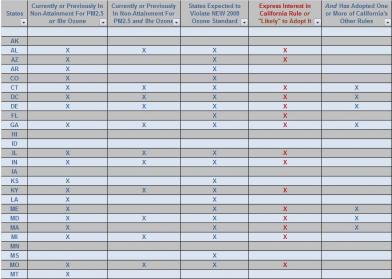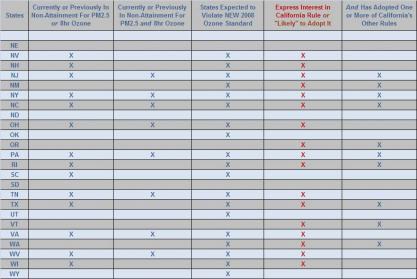

AGC of America estimates that as many as 32 states are closely following California's controversial effort to implement and enforce first-time emission limits for in-use "fleets" of off-road diesel (ORD) equipment. If these states adopt identical rules, construction companies across the nation will be forced to pay the high cost of installing aftermarket pollution controls on equipment that is currently out in the field, or face replacement and retirement as their only alternatives. Interested states admit their goal is to reduce off-road emissions of nitrogen oxide (NOx) and fine particulate matter (PM2.5) at a much faster rate than what is required by federal "Tier 1-4 standards," which set pollution limits for newly-manufactured off-road diesel engines and fuel -- but do not mandate any reductions from existing engines.
For several years, AGC of America and its California Chapters have been strongly opposing the ORD rule and pressing the California Air Resources Board for relief (click here). At the same time, AGC is actively warning its Chapters in the other 49 states that the ORD rule could set a de facto national standard that would impose an excessive, and in some cases insurmountable, economic burden on the already struggling construction industry.
Approximately 17 states have already adopted one or more of California's strict emissions standards, primarily to obtain the additional pollution reductions needed to comply with national ambient air quality standards (NAAQS). California's ORD rule is designed to quickly and steadily reduce emissions of ozone (NOx contributes to the formation of ozone) and PM2.5. California's effort comes at a time when the U.S. Environmental Protection Agency (EPA) has just set new and more stringent standards for both of these pollutants.
In the near term, almost all 50 states have to write clean air "state implementation plans" (SIP) to show EPA how they will meet the tighter federal NAAQS for ozone and/or PM. Approximately 19 states currently have air pollution problems similar to California (and that the ORD rule is designed to address) and, at a minimum, those states will likely need to access the regulatory tools already available to California -- including laws designed to reduce pollution from existing fleets of construction equipment. Any state that fails to develop an "approvable" SIP can be subject to numerous federal sanctions, including emissions caps limiting economic development and the loss of federal highway transportation funds. Unfortunately, neither scenario is promising news for the business of construction.
The Clean Air Act (CAA) generally prohibits state and local governments from setting engine emission standards for off-road diesel equipment (including diesel retrofit requirements) -- a concept called federal preemption. The statute, however, makes an exception for the state of California. To be clear, California is the only state that has the authority to set emission standards for engines in construction equipment that are more aggressive than federal standards, including retroactive requirements. But once California sets such standards, and the federal government approves of them, other states have the option of "opting-in" to California's program. Any state that elects to "opt-in" to California's ORD rule must adopt, implement and enforce (and potentially amend) it exactly as dictated by California lawmakers.
The environmental movement has targeted the construction industry as a major contributor of airborne pollutants and many states appear to be receptive to the concept of retroactive equipment "retrofit" requirements. To this end, AGC has observed an increase in the number of state construction contracts for public works projects that include bid preferences and/or specifications mandating reductions in diesel emissions. (The legality of this practice is questionable and the key issue of whether or not states and localities can accomplish indirectly what they can not do directly will certainly be the subject of future litigation.) Once California unlocks the door to broad, statewide standards for off-road diesel emissions, identical standards are likely to come pouring through it. AGC is very concerned about the costs that these standards will impose on the construction industry.
Following are answers to the most frequently asked questions about states likely to adopt California's off-road engine emission standards. Following these FAQs is a chart that shows where each state currently stands.
Q1 - Which states are currently or previously in nonattainment of the PM2.5 and/or the 8-hour ozone NAAQS?
In addition to California, 33 states are currently or previously in nonattainment of the PM2.5 and/or 8-hour ozone standards, and the federal government predicts that even more states will exceed the new and more stringent standards already scheduled to take effect over the next few years. The Clean Air Act (CAA) requires the U.S. Environmental Protection Agency (EPA) to designate areas as attainment (meeting the standard), nonattainment (not meeting the standard) or unclassifiable (insufficient data to classify) after the agency sets a new national ambient air quality standard (NAAQS), or revises an existing standard. For more information on the process EPA and the states follow to designate areas as in attainment or nonattainment for the ground-level ozone standards established in 1997 and in 2008, as well as links to nonattainment area maps, log on to http://www.epa.gov/ozonedesignations/. The designation web page on the standards established in 1997 and 2006 for fine particle pollution is online at http://www.epa.gov/pmdesignations/. The EPA Green Book, which lists nonattainment areas for all NAAQS is online at http://www.epa.gov/oar/oaqps/greenbk/index.html.Q2 - Which states are legally qualified to adopt California's ORD rule?
Based on AGC's research, almost every state is (or will be) legally qualified to adopt California's ORD rule as a result of EPA's continual process of identifying and revising federal NAAQS. The CAA allows any state that has ever had a state implementation plan (SIP) approved by federal EPA for any nonattainment area to adopt California's stronger motor vehicle standards (Section 177); the Act further allows such states to adopt California's off-road vehicle and engine standards (Section 209(e)(2)(B)). The one exception is that the Act prohibits California and other states from adopting emission standards for new engines under 175 horsepower used in construction equipment (Section 209(e)(1)). States with air pollution problems generally have two choices when deciding how to regulate emissions from mobile sources: They can follow the federal standards or the California standards. States that seek to adopt California's ORD rule must consider the following-- Non-California states must have authority under their own state law to adopt California's regulations.
- The CAA allows non-California states to adopt and enforce off-road emission standards "identical" to California's regulations (Section 209(e)(2)(B)). This identical-standard also explicitly requires that implementation and enforcement are identical to California's for off-road emissions (Section 209(e)(2)(B)(i)).
- In addition, a state choosing to adopt California's standards for off-road sources must notify the EPA administrator of its decision, although EPA has no approval role in the adoption of the state standards (Section 209(e)(2)(B)).
- Finally, opt-in states must provide two years of "lead time" following adoption of any of California's mobile source emission standards before such standards take effect in their own state (see Q5 below).
Q3 - Which states have already expressed an interest in California's ORD rule?
According to the EPA Green Book, the following states have air pollution problems similar to California's problems (i.e., they have nonattainment areas for both the 8-hour ozone and PM2.5 NAAQS) and they are likely to adopt California's ORD rule: Connecticut, Delaware, Georgia, Illinois, Indiana, Kentucky, Maryland, Michigan, Missouri, New Jersey, New York, North Carolina, Ohio, Pennsylvania, Tennessee, Virginia - plus the District of Columbia. In addition, although Alabama and West Virginia were recently re-designated by EPA as meeting the 1997 8-hour ozone standard, these states will be (once again) in nonattainment for both the 2008 ozone and 2006 PM2.5 NAAQS once "official" designations are made under the new, more stringent standards. In recent news, diesel experts tracking the issue (such as John Deere's Joe Mastanduno, whom the April 2009 edition of Construction Equipment Distribution referenced) have specifically identified the following states as areas to watch-- A group of 13 states in the Northeast, expected to adopt the regulations together;
- The Midwest, specifically around the Chicago area, the Great Lakes region including Wisconsin and Ohio;
- Texas;
- California boarder states;
- The Southeast, like Georgia and Florida; and
- The Northwest, like Oregon and Washington.
Q4 - Which states have already adopted one or more of California's other engine emission standards?
California has taken advantage of its unique authority under the Clean Air Act and has set its own emission standards for everything from cars and SUVs to diesel trucks from lawn and garden equipment to personal watercraft. At least twelve states - Connecticut, Maine, Maryland, Massachusetts, New Jersey, New Mexico, New York, Oregon, Pennsylvania, Rhode Island, Vermont and Washington - have already adopted the California emissions low-emission standards for passenger vehicles. There are a few states that are NOT on the list above that have adopted California's standards for diesel trucks, which are identical to but serve to reinforce the federal standards, like Delaware, Georgia, North Carolina, Texas - as well as Washington, DC. And at least New York has adopted California's standards for personal watercraft, such as jet skis. In addition, at least 19 states have adopted, or are in the process of adopting, California's strict new rules to reduce greenhouse gas emissions from cars, including Arizona, Colorado, Connecticut, Florida, Illinois, Iowa, Maine, Maryland, Massachusetts, Montana, New Jersey, New Mexico, New York, Oregon, Pennsylvania, Rhode Island, Utah, Vermont and Washington.Q5 - What is the "lead time" requirement for California's ORD rule to take effect in other states?
According to the Clean Air Act and EPA's "clarifying" regulations, California must first adopt its standards, and then other states may adopt the same standards provided that 1) the other state's rule does not take effect until two years after its adoption by that state, and 2) the rule is the same as the one ultimately authorized by EPA's waiver.Specifically, CAA Section 209(e)(2)(B) provides for a two-year period from adoption by another state of a regulation identical to a regulation for which California has obtained a waiver before the regulation may take effect in that other state. EPA's off-road regulations, as revised on October 8, 2008, provide some clarification of the Clean Air Act provisions:(a) ... any state other than California that has plan provisions approved under Part D of Title I of the Act (42 U.S.C. 7501 to 7515) may adopt and enforce emission standards for any period for off-road engines and vehicles subject to the following requirements:
(1) The state must provide notice to the Administrator that it has adopted such standards.
(2) Such standards may not apply to new engines smaller than 175 horsepower that are used in farm or construction equipment or vehicles, or to new locomotives or new engines used in locomotives.
(3) Such standards and implementation and enforcement must be identical, for the period concerned, to the California standards authorized by the Administrator.
(4) The state must adopt such standards at least two years before the standards first take effect.
(5) California must have adopted such standards two years before the standards first take effect in the state that is adopting them under this section.
40 CFR § 1074.110(a) (promulgated at 73 FR 59033, at 59380).
It is important to note, however, that states do not need to wait for the California standards to receive a federal preemption waiver before adopting such standards. EPA and the courts have consistently taken the position that a non-California state may adopt California standards that have not received a preemption waiver but that the state cannot enforce the rules until California wins EPA's approval.
For more information on California's ORD rule and AGC's efforts, log on to AGC's web site at http://www.agc.org/carbrule.